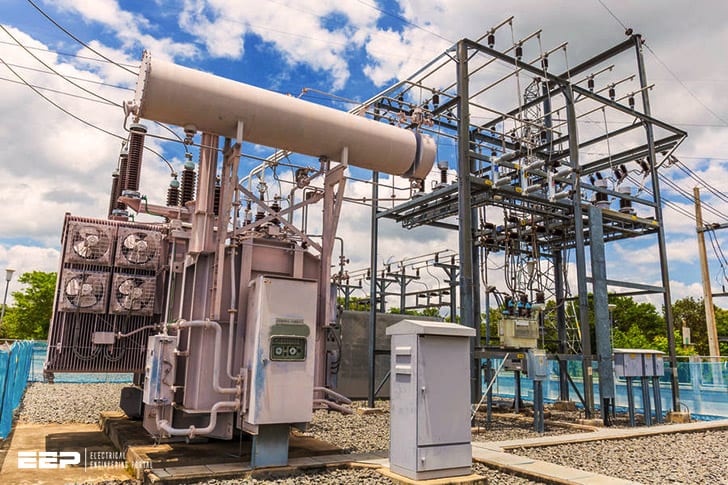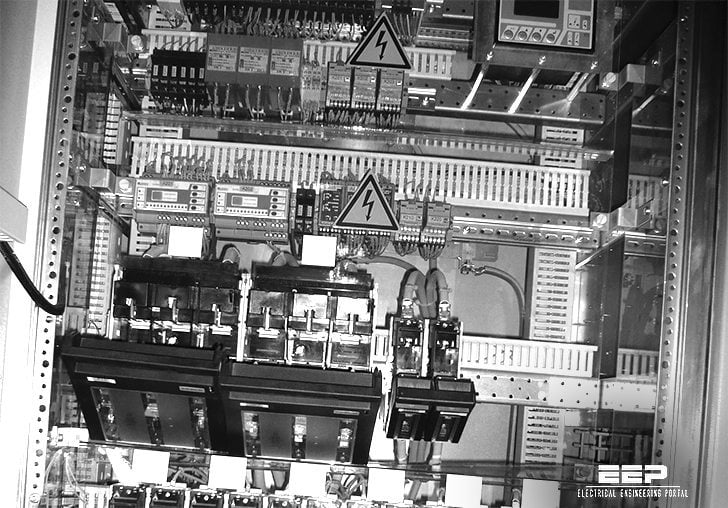A substation is a part of an electrical power system where voltage is transformed from high to low, or the reverse. It is also used to change the AC current into DC current, and vice versa. A substation can be located anywhere along the electrical power grid.
If you work in or around the electrical industry, then you are likely familiar with substation equipment. This gear is critical to the function of power plants and other large scale electrical operations. While much of it is simple in design, it must be carefully selected and installed to ensure optimal performance.
In this post, we will take a closer look at some of the most common types of substation equipment and what role they play in keeping the power flowing.
The first piece of equipment that any substation must have is a transformer. Transformers are used to step up or step down voltage levels as needed.
They are typically located near the beginning of the substation’s power flow path and serve an important regulatory function.
Next on the list is circuit breakers. These devices protect transformers and other sensitive equipment from damage by interrupting circuits when they become overloaded.
Breakers come in both high-voltage and low-voltage varieties depending on their intended application.
Switches are another key component of substation equipment. Switches provide a way to remotely control circuit breakers and other devices without having to physically access them.
This can be extremely useful in emergency situations when time is of the essence. Switches are also used to isolate sections of the substation for maintenance purposes.
Last but not least, meters are used to measure various parameters such as voltage, current, and power factor.
Meters may be analog or digital, depending on their intended use.
SUBSTATION EQUIPMENTS FULL DETAILS WITH PPT
Substation Equipment Pdf
Substation equipment is critical to the function of any electrical power system. Substations serve as the link between generation, transmission, and distribution systems, and are responsible for transforming voltage and current levels between these different system components. Without proper substation equipment, the safe and reliable operation of an electrical power system would be impossible.
There are a variety of different types of substation equipment that perform a variety of different functions. Some of the most important pieces of substation equipment include:
-Transformers: Transformers are used to change the voltage level of electricity passing through them.
This is necessary because different system components operate at different voltage levels. For example, generators typically produce electricity at high voltages, while household appliances require much lower voltages to function properly. Transformers step down the voltage level from transmission lines to a level that can be used by distribution systems (and ultimately end-users).
-Circuit breakers: Circuit breakers protect electrical equipment from damage caused by excessive currents flowing through them. When too much current flows through a circuit breaker, it trips and opens up the circuit, interrupting the flow of electricity and preventing damage to downstream equipment.
-Capacitors: Capacitors store energy in an electric field and release it when needed.
They are often used in conjunction with inductors (coils of wire) to create filters that remove unwanted frequencies from an electric signal. Capacitors are also used to provide reactive power support to help regulate voltage levels in an electrical system.
Substation Components And Their Functions
A substation is a critical part of the electrical grid. It is where high-voltage electricity from power plants is transformed into the lower voltage electricity that powers our homes and businesses. Without substations, we would not have the modern world as we know it.
There are four main components of a substation: transformers, breakers, busbars, and switches. Each plays an important role in ensuring that electricity flows safely and efficiently through the grid.
Transformers are used to change the voltage of electricity coming from power plants.
The higher the voltage, the less current is needed to transmit energy over long distances. This makes transmission more efficient and reduces loss of energy due to heat generation.
Breakers are used to protect equipment from overloads by automatically disconnecting circuits when too much current flows through them.
This prevents damage to equipment and ensures safe operation of the substation.
Busbars are made up of conductors that carry large amounts of current between different parts of the substation. They are often made from copper or aluminum because these materials have low resistance and can handle high currents without overheating.
Underground Substation Ppt
An underground substation is a substation located below ground level. They are often used when space is constrained, or when aesthetic considerations are important.
Underground substations can be more expensive to build than above-ground substations, due to the increased cost of excavating and backfilling the site.
They can also be more difficult to maintain, as access to equipment may be restricted.
In order to protect equipment from flooding or water damage, underground substations must be designed with adequate drainage and ventilation. The use of waterproofing materials is also important in preventing water ingress.
Metering Equipment in Substation
Every electrical substation, whether for utility or industrial applications, will have some type of metering equipment. The specific type of metering equipment will be determined by the function of the substation and the voltage level that is being monitored. For example, a typical residential substation will have a meter for monitoring household electricity usage, while a high-voltage substation may have several meters for different phase voltages and currents.
Meters can be either analog or digital. Analog meters use moving parts to measure current or voltage, while digital meters use electronic sensors and display results on an LCD screen. Both types of meters have their own advantages and disadvantages, but digital meters are generally more accurate and easier to read than analog meters.
Metering equipment is essential for any electrical substation because it allows operators to monitor power flows and identify problems before they cause damage or disruption. Without metering equipment, it would be very difficult to effectively manage a substation’s operations.
Substation Pdf
A substation is a critical part of the electric power grid. It is a point where electricity is transformed from one voltage to another, or distributed to multiple voltages. A substation also typically includes equipment for monitoring and controlling the flow of electricity, as well as for providing protection against faults.
A modern substation can be a very complex facility, with dozens of pieces of equipment that must work together seamlessly to provide reliable service. This blog post will provide an overview of the key components of a substation and how they work together.
The first component of a substation is the transformer.
The transformer changes the voltage of the electricity passing through it, either increasing or decreasing the voltage as needed. The transformer also serves to isolate different parts of the electrical grid from each other, which helps protect against faults and power disruptions.
The second key component is the switchgear.
Switchgear controls the flow of electricity within the substation and between different parts of the electrical grid. It includes circuit breakers, switches, and other devices that allow operators to safely control the flow of electricity. Switchgear also provides protection against faults by automatically disconnecting circuits when problems are detected.
The third important component is communication systems. Communication systems allow operators to monitor and control conditions within the substation remotely. They also provide a means for emergency personnel to coordinate their response in case of an incident at the substation.
Electrical Substation Safety Ppt
As we all know, an electrical substation is a crucial part of the power grid. Without it, electricity couldn’t be delivered to homes and businesses. But while substations are vital, they can also be dangerous places.
That’s why it’s important to follow safety protocols when working in or near one.
Some of the hazards present in a substation include high voltage equipment, exposed live wires, and flammable materials like oil and gas. It’s essential that workers take precautions to protect themselves from these dangers.
When working on or near high voltage equipment, for example, always use insulated tools and wear rubber gloves and other personal protective equipment (PPE).
Likewise, it’s important to be aware of your surroundings when working in a substation. Be sure to stay clear of exposed live wires, and never touch anything without first checking with your supervisor.
If there is a fire in the substation, immediately evacuate the area and do not re-enter until the fire has been extinguished by trained personnel.
By following these safety guidelines, you can help ensure that everyone stays safe while working in or near an electrical substation.
What is Substation
In an electrical power system, a substation is a component of the system between the generating plant and the distribution system. The function of a substation is to receive electricity from the generating plant, measure and sometimes transform it to another voltage level, then distribute it to consumers. A typical substation includes one or more high-voltage circuits (busbars), transformer equipment for changing voltages, switching gear for controlling circuits and connections, support structures, and often enclosing buildings as well.
Substations are typically located at key junctions in an electrical grid.
Substations may be owned and operated by electric utilities, independent operators known as Independent System Operators (ISOs), or other entities such as large industrial or commercial customers that connect directly to the grid. Utilities use substations to tap into transmission lines and regulate voltage levels before distributing power along lower-voltage distribution feeders.
Substation Bus Schemes Ppt
A substation is a high voltage electrical system used to switch equipment and connect it to the power grid. The bus scheme is the configuration of how the equipment in the substation is connected together. There are several different types of bus schemes, each with its own advantages and disadvantages.

Credit: www.substation-safety.com
What Equipment is in a Substation?
A substation is a crucial part of the electrical power grid. It is a medium voltage (MV) or high voltage (HV) facility where electricity is converted from one voltage to another, either for purposes of stepping energy down to a lower level before it is distributed to end users, or for stepping energy up to a higher level before it enters the transmission system.
In addition to housing equipment that transforms electricity from one voltage to another, substations also contain devices that protect equipment and personnel from faults on the system.
These devices are called circuit breakers, and they can automatically detect and isolate problems in the system so that repairs can be made quickly and safely.
The following are some of the key pieces of equipment found in most substations:
-Circuit breakers: As mentioned above, these devices are used to protect other equipment in the substation from damage due to faults on the electrical system.
Circuit breakers can be either manually operated or automated.
-Transformers: These devices change the voltage of electricity passing through them by using electromagnetic induction. The transformer shown in Figure 1 is an example of a device that steps energy down from MV to LV.
-Capacitors and reactors: Capacitors store electric charge, while reactors limit the flow of current in a circuit. Both types of devices are used to help regulate voltages within safe levels at various points throughout the substation.
-Metering equipment: This type of equipment is used to measure various parameters such as voltage, current, power factor, and frequency.
This information helps operators monitor conditions on the electrical system so that they can make necessary adjustments as needed.
-Protective relays: Protective relays are specialized switches that are designed to open circuits automatically in case of an emergency situation such as a fire or severe weather event.
What are the Three Types of Substations?
The three types of substations are transmission, distribution, and service. Transmission substations step down high-voltage electricity to a lower voltage for local distribution. Distribution substations distribute electricity at a lower voltage to consumers.
Service substations provide power to customers who have a demand that is too small or irregular for their own dedicated line from the utility company.
What are the Three Main Components of a Unit Substation?
The three main components of a unit substation are the primary, secondary, and tertiary windings. The primary winding is the one that provides the most voltage to the substation, while the secondary winding provides the least. The tertiary winding is in between these two voltages and provides a balanced voltage to the substation.
What are the Equipment Used in Pole Mounted Substation?
Pole mounted substations are typically used to distribute electricity at the lower voltages, such as secondary distribution levels. The equipment used in these substations includes:
-Transformers: to step down the voltage from the primary distribution system
-Circuit breakers and switches: for controlling and protecting the system
-Metering equipment: for monitoring voltage, current, and power consumption
-Lightning arresters: for protection against lightning strikes
In addition to this electrical equipment, pole mounted substations also require a structure to support everything. This is usually a metal or concrete pole, which must be strong enough to withstand wind loads and any potential impacts from vehicles or other objects.
Conclusion
A substation is a critical part of the electrical grid, where power is transformed from high voltages to lower voltages for distribution. The equipment in a substation must be able to withstand extreme temperatures and conditions.



